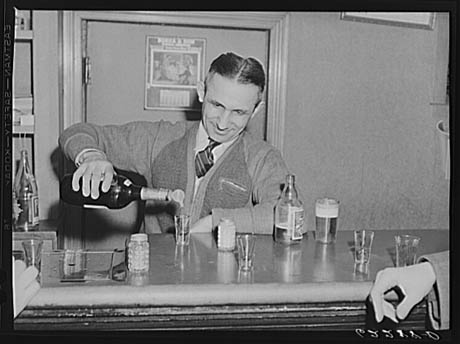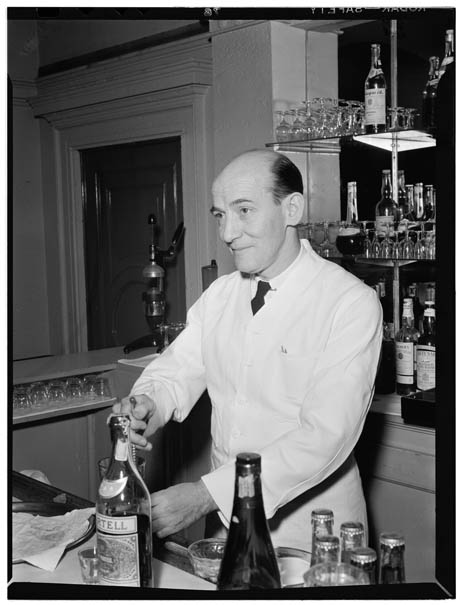
IMAGE: Bartender in Catholic Sokol Club, Ambridge, Pennslyvania; Library of Congress Prints & Photographs division, Washington, DC, via Rebecca Federman.
Commemorative cocktail names act as a sort of alcoholic telegraph, a filtered, patchy, and somewhat unreliable headline service calling out public figures, trends, or events, from Obama’s inauguration to the introduction of a new steam engine. Rebecca Federman, whose blog describes her favorite finds from New York Public Library’s vast archive of historic menus and cookbooks, was the perfect person to dig up obscure examples of the form for the food issue of the New City Reader, and I am very pleased to reproduce her article in full below.
However, you’ll have to pick up your own copy of the New City Reader at the New Museum (or download the pdf here) to get hold of the recipe for our own commemorative cocktail: The Last Newsman. At the urging of my co-editors, Will Prince and Krista Ninivaggi, mixologist Greg Seider combined scotch, bourbon, vermouth, two kinds of bitters, and a brandied cherry to create a cocktail that will keep Summit Bar drinkers up to speed with what the executive editors of the New City Reader delicately refer to as “epochal shifts presently occurring in the information industry.”
•••
A Short, Non-Linear History Of The Commemorative Cocktail by Rebecca Federman
While one would be hard-pressed to find a salad or casserole named after military weaponry, the French 75 — a tongue-tingling concoction of champagne, gin, lemon juice, and sugar — is an offering found on many a cocktail menu. It was, in fact, named in tribute to a 75-mm quick-firing gun used widely during World War I.
Commemorative cocktails are born out of an incredible assortment of historical events, from monumental achievements and epic heroes to fleeting trends and otherwise insignificant peculiarities. The poetic bartenders (or publicists) who imagined the mixed drinks described below were commemorating, in liquid form, a host of special events, people, places, and innovations. And, yes, even the occasional scandal.
The rather delightful result is that even the most news-averse barfly can keep up-to-date on current events, from union strikes to space travel, simply by sampling fresh additions to the cocktail menu.

IMAGE: Portrait of Joe Helbock, Charlie’s Tavern, New York, N.Y., ca. Mar. 1947; Library of Congress Prints & Photographs division, Washington, DC, via Rebecca Federman.
The First Japanese Delegation
In David Wondrich’s Imbibe!, a fascinating portrait of the nineteenth-century bartender Jerry Thomas, Wondrich specifically calls out Thomas’ recipe for the Japanese Cocktail as “a fine example of yet another Cocktail-naming gambit, the commemorative Cocktail.” The story, as Wondrich tells it, began in 1860 when the first Japanese delegation to the United States ended their tour in New York. Of the many esteemed guests from Japan, one became more infamous than the others. Tommy, as he was commonly referred to in the American media, was an English-speaking member of the Japanese delegation whose fondness for both pretty women and booze formed the subject of several newspaper articles. Wondrich deduces that since Tommy and company were staying at the Metropolitan Hotel, just one block from the bar where Jerry Thomas was mixologist-in-residence, the bartender created a drink in their honor — or lack thereof.
JAPANESE COCKTAIL
(from Jerry Thomas’ Bar-tender’s Guide, as reprinted in David Wondrich’s Imbibe!)
– 1 Tablespoon of Orgeat syrup
– ½ teaspoon of Bogarts bitters
– 1 wine glass (2 ounces) of brandy
– 1 or 2 pieces of lemon peel
Fill a tumbler one-third with ice, and stir well with a spoon.
England’s Industrial Shutdown
After what the New York Times referred to as “many wearisome days of fruitless squabbling,” on May 3, 1926, roughly three million members of England’s largest labor union, the Trades Union Congress (TUC), went on strike in support of British coal miners whose pay was being decreased despite increased working hours. The strike’s members included workers in England’s transportation and building trades; iron, steel and metal workers; and workers in the paper and printing industries. A nation-wide shutdown was only narrowly averted by the efforts of volunteer workers. The TUC finally called off the strike on May 12, 1926.
STRIKE’S OVER COCKTAIL
(from the Savoy Cocktail Book)
According to the note attached to this recipe, Harry Craddock, the head bartender at the Savoy Hotel, created this cocktail on May 12, 1926, to commemorate the end of the General Strike in England.
– 1/4 Lemon or Lime Juice
– 1/4 Swedish Punch
– 1/2 Gin
Shake well, and strain into a cocktail glass.
Man On The Moon
On July 25, 1969, a small article ran in the New York Times announcing the “Moonshot,” a cocktail created by French champagne and cognac producers to commemorate the Apollo 11 flight. The publicist for the French producers—the Moonshot was unveiled not at a bar but at a press conference—pointed out that the drink is best served on the rocks, because, as he correctly noted, “the moon’s surface is rock.”
MOONSHOT
(from the New York Times, July 25, 1969)
– 3 ounces French Champagne
– 2 ounces cognac
– 3 ounces orange juice
Mix well, and serve over ice.
The Eliot Spitzer Scandal
While not a cocktail in the traditional sense, the “Client #9 Champagne Oyster Shooter” appeared on the menu of the Grand Central Oyster Bar on March 12, 2008, the same day that Eliot Spitzer announced his resignation as governor of New York. Spitzer was referred to as Client #9 in an FBI affidavit detailing the operations of the Emperor’s Club, a high-end prostitution service that Spitzer frequented. When his scandalous assignations were leaked to the media, the Oyster Bar was there to commemorate it. The price for the champagne oyster shooter was jokingly listed at $5,000 but actually only cost an easy-to-swallow $7.95.
[NOTE: This article is from the food issue of the New City Reader, and was written by Rebecca Federman, the librarian and electronic resources coordinator for the New York Public Library’s culinary collections, and the author of her own well-worth-following blog, Cooked Books.]